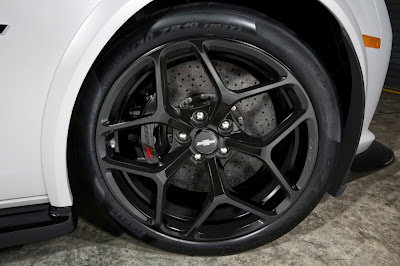The refreshed look of the Camaro that's supposed to keep it hot until the next generation is good for sales. The car looks sharper and the rear ends digs deep into Chevy's heritage - the 1967 Chevrolet Impala.. but what's bound to get a lot of people talking is the beast of a machine that is the Camaro Z/28. Chevy means business with this car. No matter how you look at it, this car screams track-ready performance.
On the outside, a larger front splitter and rear spoiler replace the ones used on the run-of-the-mill SS. Flared wheel arches with nearly flush wheels show that the front and rear tracks have been widened. Lightweight 19" wheels are wrapped in massive 305-series tires and larger brake rotors and callipers are clearly visible. But there are even more changes under all the visible upgrades.
There has been rumours towards the end of last year that the 7.0 litre LS7 V8 used in the Corvette Z06 will find its way under the hood of a Camaro. "Leaked" data showed that the engine seems to actually be an option on the Camaro spec sheet.. but it wasn't confirmed until the reveal of the Z/28. The car will come equipped with the LS7 V8 producing "at least" 500 hp and 470 lb-ft of torque. The engine will be mated to a 6-speed Tremec TR6060 manual transmission and I doubt it will be offered with an automatic like the ZL1.
The engine is hand-assembled from top end parts including:
- Titanium intake valves and connecting rods
- Sodium filled exhaust valves for better heat dissipation
- CNC-ported aluminum cylinder heads
- Forged steel crankshaft and main bearing caps
- High-lift camshaft
- Hydroformed exhaust headers
- 10.5-quart dry sump oiling system
All of this allows the engine to use a high 11.0:1 compression ratio and revs up to a 7,000 rpm redline, which is very impressive for a 7.0 litre V8.
On the inside, excellent Recaro seats await the driver and a meaty flat-bottom steering wheel that looks to be wrapped in suede. Air conditioning has been made a stand alone option so that those who just want to save as much weight as possible and focus on track performance can keep it out.
To help put the power down, huge 305/30ZR19 ultra high performance Pirelli PZero Trofeo R tires (first on a production car) wrap the 19" lightweight forged wheels. That size tire is also believed to be the widest used on the front of any production car. Behind the wheels and tires sit massive brakes front and back to shed off speed when needed. On the front, 394 x 36 mm brembo Carbon Ceramic Matrix™ rotors are matched with 6 piston callipers. On the back, 390 x 32 mm fixed monoblock callipers and 4 piston callipers are utilized. This setup saves about 28 lb. compared to 2-piece steel rotors. Other chassis and suspension revisions have been made which achieve impressive feats such as 1.05 g lateral acceleration around corners and 1.50 g deceleration (that's high!) along with consistent brake feel and performance.
All of the upgrades result in the Z/28 being a whole 3-seconds quicker than the ZL1 on average, according to Chevrolet. In Car and Driver's Lightning Lap 2013, the Camaro ZL1 posted a lap time of 2:57.5. If the 3-second lead holds true on VIR (the track that Car and Driver holds Lightning Lap tests at), the Z/28 could post a lap time of 2:54.5 - that would make it quicker than cars like the 2011 Porsche 911 GT3 RS, Lexus LFA and Ferrari 430 Scuderia all of which are several hundred pounds lighter and have better power-to-weight ratios with the Lexus LFA actually have more gross power. Now that would earn some serious bragging rights..
This is what the Camaro lineup needed all along. Although the Camaro SS 1LE has already posted better lap times than the Boss 302 Laguna Seca, it didn't seem to have grabbed as much interest or improved the image of the Camaro lineup as much as the Boss 302 did. It could be because the Boss 302 was first to the party as the very quick naturally aspirated car. It could be that the Boss 302 was more track focused and got its own engine while the Camaro had to do with only suspension upgrades (which were very effective). It could even be as simple as more effective advertising by Ford. Whatever the case may be, the Camaro Z/28 is very different from the SS 1LE and should do the same to the Camaro lineup as did the Boss 302 to the Mustang lineup. Will Ford and Chrysler (SRT) have an answer to this? I doubt they will let this go without a competitor. This is a great time to be a car enthusiast!
Source: Slash Gear and Chevrolet

















The Camaro is stylish and presents a new look. I like the wheels which offers high performance, quality and just a glimpse makes me want to try this ride. The unique designs perfect and suitable for this Camaro. For a new design in the market this is awesome work.
ReplyDelete2014 Chevrolet Camaro Z/28. He's emblematic with improved aerodynamic performance and stability at high speeds.
ReplyDeleteChevrolet unveiled the redesigned 2014 Camaro line at the Auto Show New York, including the return of the Z/28, the flagship model of Camaro history.
2014 Chevrolet Camaro Z/28 presents a revised exterior design that integrates high performance aerodynamics for a more efficient cooling and stability at high speeds.